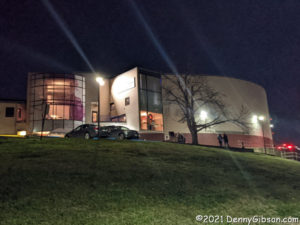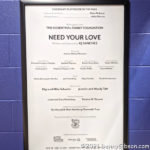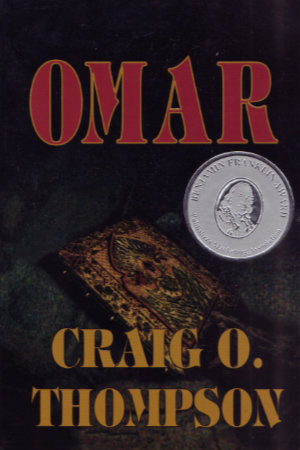 This makes two consecutive book reviews that are seriously belated and that’s hardly their only connection. I wasn’t even aware of either the book or its author when I arrived at the 2022 Lincoln Highway Association conference but, John Jackson, co-author of that other book, was. More importantly, John was aware that Thompson was at the conference to get some insight into the days of named auto trails. He is working on a book based on the true story of a 1920s medical emergency that involved the Yellowstone Trail. John was also aware that I had recently traveled the Yellowstone Trail and he intended to get the two of us together at the conference. John wasn’t actually present when Thompson and I first met but, because of his earlier comments to both of us, no introduction was required when we found ourselves sitting at the same table for a presentation.
This makes two consecutive book reviews that are seriously belated and that’s hardly their only connection. I wasn’t even aware of either the book or its author when I arrived at the 2022 Lincoln Highway Association conference but, John Jackson, co-author of that other book, was. More importantly, John was aware that Thompson was at the conference to get some insight into the days of named auto trails. He is working on a book based on the true story of a 1920s medical emergency that involved the Yellowstone Trail. John was also aware that I had recently traveled the Yellowstone Trail and he intended to get the two of us together at the conference. John wasn’t actually present when Thompson and I first met but, because of his earlier comments to both of us, no introduction was required when we found ourselves sitting at the same table for a presentation.
I know I’ve mentioned before that I do not read much fiction these days so it is unlikely I would have stumbled across Omar on my own. Thompson and I had several discussions about the Yellowstone Trail and early automobile travel in general, and that gave me the personal connection that made me want to start reading the book. The book itself made me not want to quit once I had started. It’s a page-turner of the first order.
By simplifying the plot to a ridiculous degree I can describe it as a race between terrorists and government agencies to reach a treasure. The treasure isn’t a simple stash of cash or gold bars but an exquisitely bound book that went down with the Titanic. Those elements alone bring bookbinding, deep sea exploration, and maritime law into the mix. Toss in an airport bombing, high-speed shoot-outs, kidnapping, and some professional rivalry and betrayal and there are enough plot threads to all but assure at least one is left dangling suspensefully every page or so.
And the bookbinding and sea exploring aspects are not dismissed with a few words of awe and wonder. They are covered with some serious discussion of craft, technology, and even a little chemistry.
I started this review with an admission of being late to the game but I’m not just a little late; I’m over twenty years late. The 1993 World Trade Center bombing is mentioned a few times in this book as an example of a major terrorist attack. It surely loomed large in Thompson’s mind as he constructed this novel in the latter half of the 1990s. On the day that Omar was published, August 1, 2001, people knew that terrorism on the scale Thompson describes was possible but not many thought it likely. Less than a month and a half later we knew better.
Omar Craig O. Thompson, StrataGem Press (August 1, 2001), 5.25 x 8.25 inches, 624 pages, ISBN 978-0967520711
Available through Amazon.


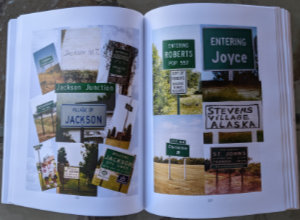
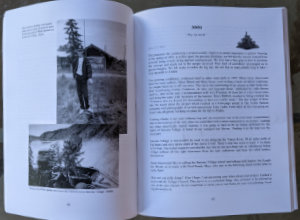
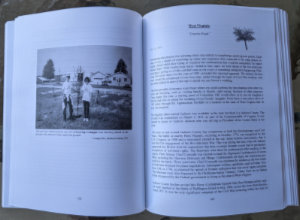
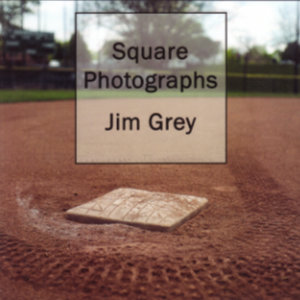
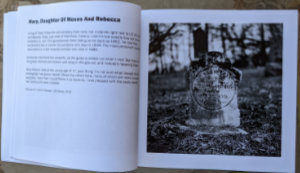
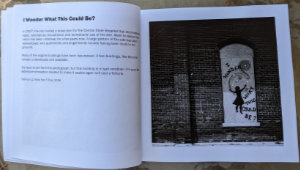
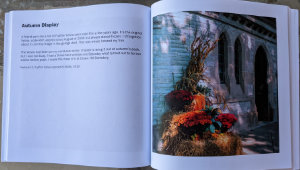
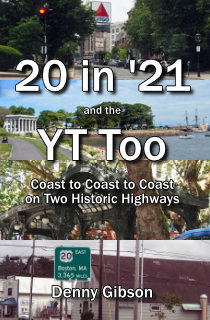 Missed it by that much. I had this really great idea for a book title, and even figured out the story that would fit it. I would drive one way across the country on the Yellowstone Trail and the other way on US 20. I would do this in the year 2020, and the resulting travelogue would be perfectly described by that catchy title: 20 in ’20 and the YT Too. But COVID-19 played havoc with 2020 travel plans and the wonderful title’s “best if used by” date came and went. I made the planned trip a year later and adjusted the title appropriately. It’s admittedly not quite the same but it’s not horrible. Is it? Well?
Missed it by that much. I had this really great idea for a book title, and even figured out the story that would fit it. I would drive one way across the country on the Yellowstone Trail and the other way on US 20. I would do this in the year 2020, and the resulting travelogue would be perfectly described by that catchy title: 20 in ’20 and the YT Too. But COVID-19 played havoc with 2020 travel plans and the wonderful title’s “best if used by” date came and went. I made the planned trip a year later and adjusted the title appropriately. It’s admittedly not quite the same but it’s not horrible. Is it? Well?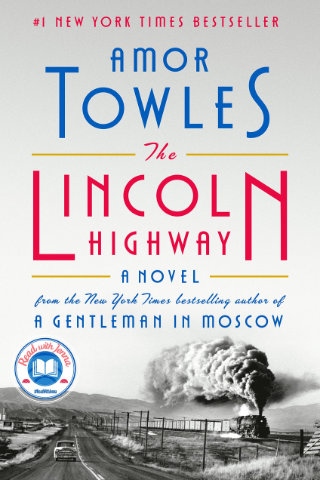 This post is a direct violation of one of the claims made on this blog’s “About” page. There the claim is made that “You will not be seeing a review of the latest novel…”. I suppose I could claim that, at the time of this review, The Lincoln Highway: A Novel is no longer the absolute latest novel, but the fact that it is a “#1 New York Times Best Seller” means it is precisely the sort of mainstream major publisher offering I had in mind when I made that claim. My primary defense is that I was tricked into reading it. Realizing that not everyone will see that as a legitimate justification, I will try to minimize the impact of the violation by not doing a very good job.
This post is a direct violation of one of the claims made on this blog’s “About” page. There the claim is made that “You will not be seeing a review of the latest novel…”. I suppose I could claim that, at the time of this review, The Lincoln Highway: A Novel is no longer the absolute latest novel, but the fact that it is a “#1 New York Times Best Seller” means it is precisely the sort of mainstream major publisher offering I had in mind when I made that claim. My primary defense is that I was tricked into reading it. Realizing that not everyone will see that as a legitimate justification, I will try to minimize the impact of the violation by not doing a very good job.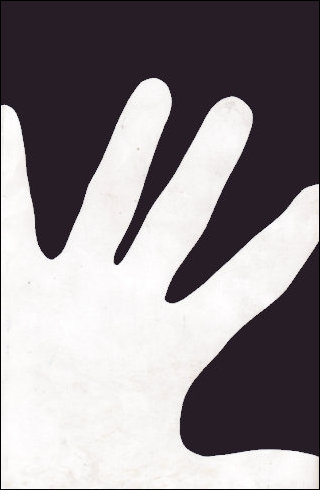 I got this book from Billy on May 7, 2015. I finished reading it on March 15, 2022. It is, as Billy himself admits and my elapsed reading time confirms, “a difficult read”. “Most people,” he says, “have understandably given up on it.” I was determined not to be like most people — no matter how long it took.
I got this book from Billy on May 7, 2015. I finished reading it on March 15, 2022. It is, as Billy himself admits and my elapsed reading time confirms, “a difficult read”. “Most people,” he says, “have understandably given up on it.” I was determined not to be like most people — no matter how long it took.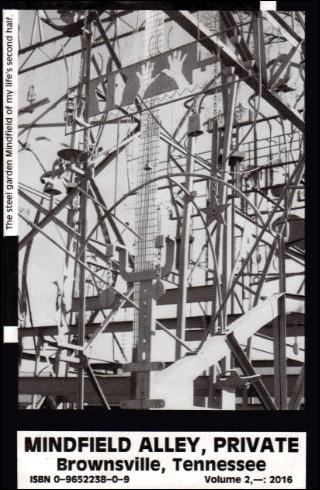 The book has been called a semi-autobiographical novel. According to Billy, it tells about his early life. “The best story I can tell in words is there if one really wants to know it”, he says. The writing style has been called stream of consciousness. In some manner, “stream of consciousness” and “semi-autobiographical” might also apply to the giant metal sculpture that is his life work. Its picture is on the book’s back cover. It is what initially made me and most others aware of Billy’s existence. When I first happened upon the sculpture in 2005, I thought its name, “Billy Tripp’s Mindfield”, might have been the title of a misplaced Beatles song, and learning that William Blevins Tripp is the artist’s real name has not entirely erased that image.
The book has been called a semi-autobiographical novel. According to Billy, it tells about his early life. “The best story I can tell in words is there if one really wants to know it”, he says. The writing style has been called stream of consciousness. In some manner, “stream of consciousness” and “semi-autobiographical” might also apply to the giant metal sculpture that is his life work. Its picture is on the book’s back cover. It is what initially made me and most others aware of Billy’s existence. When I first happened upon the sculpture in 2005, I thought its name, “Billy Tripp’s Mindfield”, might have been the title of a misplaced Beatles song, and learning that William Blevins Tripp is the artist’s real name has not entirely erased that image.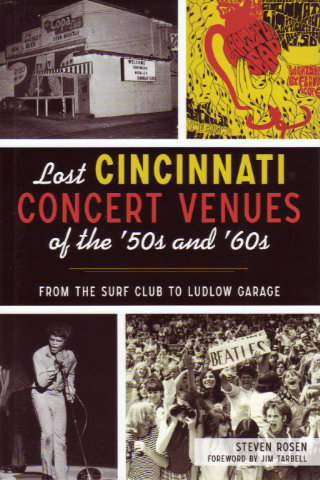
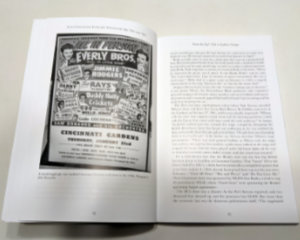

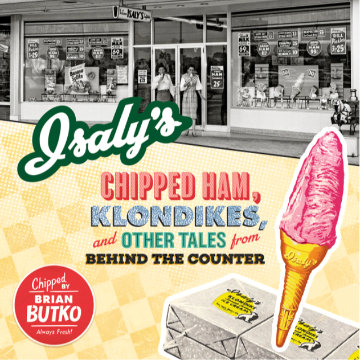 It’s been said you should write what you know. Brian Butko may or may not believe that but there is reason to think he might believe even more in the corollary: Write what you want to know. I frequently get the impression that Butko enjoys the hunt as much as the kill, research as much as publishing, learning as much as teaching. Isaly’s Chipped Ham, Klondikes, and Other Tales from Behind the Counter gives me that impression in spades. This is Butko’s second run at the subject having published Klondikes, Chipped Ham, & Skyscraper Cones: The Story of Isaly’s in 2001. I’m not familiar with the earlier book but know that there is some unavoidable overlap. No surprise there. There is no doubt a multitude of reasons for the redo but I’ll suggest — and this is pure conjecture — that not only was it tackled in order to improve the story with knowledge learned in the intervening twenty years but as an excuse to learn even more.
It’s been said you should write what you know. Brian Butko may or may not believe that but there is reason to think he might believe even more in the corollary: Write what you want to know. I frequently get the impression that Butko enjoys the hunt as much as the kill, research as much as publishing, learning as much as teaching. Isaly’s Chipped Ham, Klondikes, and Other Tales from Behind the Counter gives me that impression in spades. This is Butko’s second run at the subject having published Klondikes, Chipped Ham, & Skyscraper Cones: The Story of Isaly’s in 2001. I’m not familiar with the earlier book but know that there is some unavoidable overlap. No surprise there. There is no doubt a multitude of reasons for the redo but I’ll suggest — and this is pure conjecture — that not only was it tackled in order to improve the story with knowledge learned in the intervening twenty years but as an excuse to learn even more.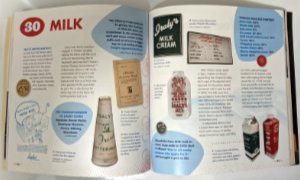 In the middle half of the twentieth century, Isaly’s was a major regional presence whose farms, factories, and stores helped feed a whole lot of people in northeast Ohio and northwest Pennsylvania. The arc of that presence is not unique. It was a family business that saw the success and growth of the first few generations eventually fade away in corporate buyouts. I’ve lived in Ohio my entire life but we missed each other. My neighborhood has been the state’s southwest corner, and the closest Isaly’s ever came to my home was Columbus. Although a few Columbus stores remained in the late 1960s and it’s possible that I saw one, I have no memory of it. The company entered Columbus in 1935, peaked there in the 1940s, and officially began its exit in 1954. Everything I know about Isaly’s I learned from Brian Butko. Brian Butko learned from family members, former employees, company records, newspapers, and libraries.
In the middle half of the twentieth century, Isaly’s was a major regional presence whose farms, factories, and stores helped feed a whole lot of people in northeast Ohio and northwest Pennsylvania. The arc of that presence is not unique. It was a family business that saw the success and growth of the first few generations eventually fade away in corporate buyouts. I’ve lived in Ohio my entire life but we missed each other. My neighborhood has been the state’s southwest corner, and the closest Isaly’s ever came to my home was Columbus. Although a few Columbus stores remained in the late 1960s and it’s possible that I saw one, I have no memory of it. The company entered Columbus in 1935, peaked there in the 1940s, and officially began its exit in 1954. Everything I know about Isaly’s I learned from Brian Butko. Brian Butko learned from family members, former employees, company records, newspapers, and libraries. 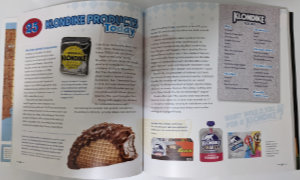 There were other innovations such as Skyscraper Cones, Party Slices, and Klondike Bars. Klondike Bars were the biggie. The only Isaly’s product to have success nationally, they are still available today although they are made by Unilever and no longer bear the Isaly’s name. They do, however, still bear the Isaly’s bear.
There were other innovations such as Skyscraper Cones, Party Slices, and Klondike Bars. Klondike Bars were the biggie. The only Isaly’s product to have success nationally, they are still available today although they are made by Unilever and no longer bear the Isaly’s name. They do, however, still bear the Isaly’s bear. Unlike me, Brian has plenty of personal Isaly’s memories. He says that his earliest was of their macaroni and cheese. His excitement is evident when given access to a 3-ring binder of company recipes. He finds the sought-after Baked Macroni then writes, “I have yet to try the official recipe…”. The fact that the recipe yields 60 servings might be one deterrent but I think I also detect a little fear that today’s result might not live up to yesterday’s memories. I, for one, encourage Brian to face his fear and look that macaroni right in the elbow. Finding 59 mac & cheese eaters should be easy.
Unlike me, Brian has plenty of personal Isaly’s memories. He says that his earliest was of their macaroni and cheese. His excitement is evident when given access to a 3-ring binder of company recipes. He finds the sought-after Baked Macroni then writes, “I have yet to try the official recipe…”. The fact that the recipe yields 60 servings might be one deterrent but I think I also detect a little fear that today’s result might not live up to yesterday’s memories. I, for one, encourage Brian to face his fear and look that macaroni right in the elbow. Finding 59 mac & cheese eaters should be easy.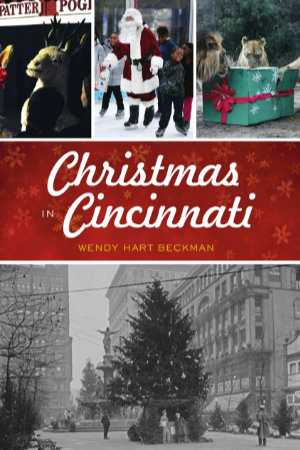 This History Press publication, as is their standard formula, is built around lots of photos both old and new. In this case, a few of those photos are mine. I won’t pretend that isn’t what made me aware of the book and triggered this review but will point out that the book does fit handily into the local-author-local-subject category that I’m fond of talking about. The local author, Wendy Hart Beckman, isn’t a native Cincinnatian but has spent much of her adult life here. I’m thinking that her New England background might actually help in recognizing what is unique or even just a little different about Christmas in Cincinnati.
This History Press publication, as is their standard formula, is built around lots of photos both old and new. In this case, a few of those photos are mine. I won’t pretend that isn’t what made me aware of the book and triggered this review but will point out that the book does fit handily into the local-author-local-subject category that I’m fond of talking about. The local author, Wendy Hart Beckman, isn’t a native Cincinnatian but has spent much of her adult life here. I’m thinking that her New England background might actually help in recognizing what is unique or even just a little different about Christmas in Cincinnati.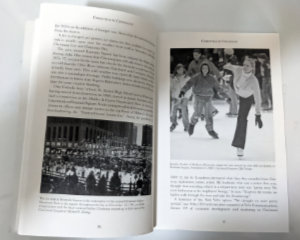 “Things to Do” in Cincinnati around Christmas time include skiing, sledding, and ice skating on Fountain Square. Shopping and visiting Santa in the numerous downtown stores was once a major draw in the days leading up to the holiday but the stores and the shoppers slipped away to the suburbs some time back. In 2020, COVID-19 nearly put a stop to in-person shopping anywhere and only time will tell if it ever fully returns. The same is true of sitting on jolly men’s laps. Beckman includes “Donating” among things to do and writes about several Cincinnati signature campaigns like the Ruth Lyons Children’s Fund and Neediest Kids of All.
“Things to Do” in Cincinnati around Christmas time include skiing, sledding, and ice skating on Fountain Square. Shopping and visiting Santa in the numerous downtown stores was once a major draw in the days leading up to the holiday but the stores and the shoppers slipped away to the suburbs some time back. In 2020, COVID-19 nearly put a stop to in-person shopping anywhere and only time will tell if it ever fully returns. The same is true of sitting on jolly men’s laps. Beckman includes “Donating” among things to do and writes about several Cincinnati signature campaigns like the Ruth Lyons Children’s Fund and Neediest Kids of All.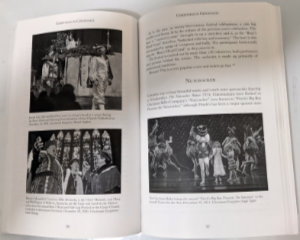 There are indeed plenty of things to do and hear in Cincinnati but there are even more “Things to See”. Beckman lists many Nativity scenes and light displays including some at private residences that have become must-sees over the years. The Cincinnati Zoo’s “Festival of Lights” and the tree on Fountain Square are in that must-see category. What might be considered the big three of Cincinnati Christmas events are on Beckman’s “Things to See” list. The oldest is Boar’s Head and Yuletide Festival which has been celebrated in Cincinnati since 1939. That’s clearly long enough ago to qualify as a true tradition but the festival’s history goes back another 600 years in England. Number two is The Nutcracker which the Cincinnati Ballet Company has been doing since 1974. The newest of the three is Playhouse in the Park’s production of A Christmas Carol which dates to 1991.
There are indeed plenty of things to do and hear in Cincinnati but there are even more “Things to See”. Beckman lists many Nativity scenes and light displays including some at private residences that have become must-sees over the years. The Cincinnati Zoo’s “Festival of Lights” and the tree on Fountain Square are in that must-see category. What might be considered the big three of Cincinnati Christmas events are on Beckman’s “Things to See” list. The oldest is Boar’s Head and Yuletide Festival which has been celebrated in Cincinnati since 1939. That’s clearly long enough ago to qualify as a true tradition but the festival’s history goes back another 600 years in England. Number two is The Nutcracker which the Cincinnati Ballet Company has been doing since 1974. The newest of the three is Playhouse in the Park’s production of A Christmas Carol which dates to 1991.